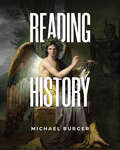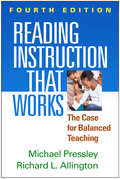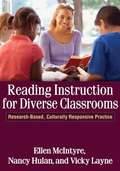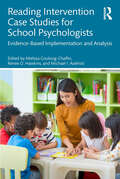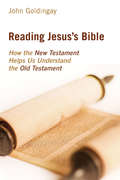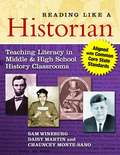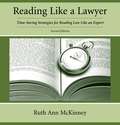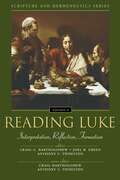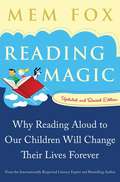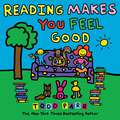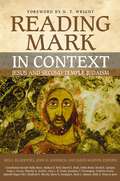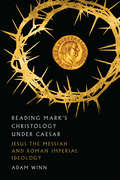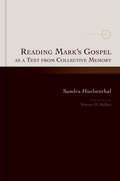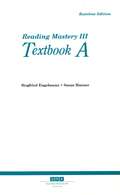- Table View
- List View
Reading History
by Michael BurgerHistory students read a lot. They read primary sources. They read specialized articles and monographs. They sometimes read popular histories. And they read textbooks. Yet students are beginners, and as beginners they need to learn the differences among various kinds of readings – their natures, their challenges, and the unique expectations one needs to bring to each of them. Reading History is a practical guide to help students read better. Uniquely designed with the author’s engaging explanations in the margins, the book describes primary sources across various genres, including documents of practice, treatises, and literary works, as well as secondary sources such as textbooks, articles, and monographs. An appendix contains tips and questions for reading primary or secondary sources. Full of practical advice and hands-on training that allows students to be successful, Reading History will cultivate a wider appreciation for the discipline of history.
Reading Instruction 6 (Ready Common Core)
by Curriculum Associates*This textbook has been transcribed in UEB, formatted according to Braille textbook formats, proofread and corrected.
Reading Instruction That Works, Fourth Edition: The Case for Balanced Teaching
by Michael Pressley Richard L. AllingtonThis widely adopted text and K-8 practitioner resource demonstrates how successful literacy teachers combine explicit skills instruction with an emphasis on reading for meaning. Distinguished researcher Richard L. Allington builds on the late Michael Pressley's work to explain the theories and findings that guide balanced teaching and illustrate what exemplary lessons look like in action. Detailed examples offer a window into highly motivating classrooms around the country. Comprehensive in scope, the book discusses specific ways to build word recognition, fluency, vocabulary, and comprehension, especially for readers who are struggling. New to This Edition *Updated throughout to reflect important recent research advances. *Chapter summing up the past century's reading debates and the growing acceptance of balanced teaching. *New and revised vignettes of exemplary teachers.
Reading Instruction for Diverse Classrooms
by Nancy Hulan Ellen McintyreThis practical, teacher-friendly book provides indispensable guidance for implementing research-based reading instruction that is responsive to students' diverse cultural and linguistic backgrounds. Structured around the "big five" core topics of an effective reading program phonemic awareness, phonics, fluency, vocabulary, and comprehension the book explains tried-and-true teaching strategies for fostering all students' achievement. Key topics include engaging diverse students in classroom discussion, involving families in learning, and assessing and teaching new literacies. Numerous classroom examples demonstrate a wide range of easy-to-implement lesson ideas and activities for students at different grade levels, including struggling learners. Issues specific to English language learners are woven throughout the chapters.
Reading Intervention Case Studies for School Psychologists: Evidence-Based Implementation and Analysis
by Michael I. Axelrod Melissa Coolong-Chaffin Renee O. HawkinsReading Intervention Case Studies for School Psychologists provides vivid, real-world examples of school-based interventions targeting students’ phonological awareness, phonics, fluency, and comprehension in reading. This book offers a rich variety of applied reading interventions in school settings , spanning strategies such as incidental teaching, word boxes, peer tutoring, taped words, story mapping, and beyond. Each case includes thorough descriptions of the specific area of concern, detailed intervention protocols, data collection and analysis methods, and tips for ensuring social acceptability and treatment integrity. School psychologists, along with related professionals in special education, general education, and speech-language pathology, will come away with new insights into this comprehensive set of well-researched and frequently applied reading interventions.
Reading Jesus's Bible: How the New Testament Helps Us Understand the Old Testament
by John GoldingayFor Jesus and his contemporaries, what we now know as the Old Testament was simply the Scriptures—and it was the fundamental basis of how people understood their relationship with God. In this book John Goldingay uncovers five major ways in which the New Testament uses the Old Testament. His discussion paves the way for contemporary readers to understand and appreciate the Old Testament more fully. Along with an overview of how Jesus and the first Christian writers read the Old Testament, illustrated with passages from Matthew, Romans, 1 Corinthians, and Hebrews, Goldingay offers a straightforward introduction to the Old Testament in its own right. Reading Jesus's Bible will shed fresh Old Testament light on Jesus, God, and the church for readers today.
Reading Jesus's Bible: How the New Testament Helps Us Understand the Old Testament
by John GoldingayFor Jesus and his contemporaries, what we now know as the Old Testament was simply the Scriptures—and it was the fundamental basis of how people understood their relationship with God. In this book John Goldingay uncovers five major ways in which the New Testament uses the Old Testament. His discussion paves the way for contemporary readers to understand and appreciate the Old Testament more fully. Along with an overview of how Jesus and the first Christian writers read the Old Testament, illustrated with passages from Matthew, Romans, 1 Corinthians, and Hebrews, Goldingay offers a straightforward introduction to the Old Testament in its own right. Reading Jesus's Bible will shed fresh Old Testament light on Jesus, God, and the church for readers today.
Reading Like A Historian: Teaching Literacy In Middle And High School History Classrooms
by Sam Wineburg Daisy Martin Chauncey Monte-SanoFeaturing an expanded introduction, this award-winning bestseller has been updated to link curriculum to the Common Core State Standards. This popular text shows how to apply Wineburg’s highly acclaimed approach to teaching― Reading Like a Historian―to middle and high school classrooms, increasing academic literacy and sparking students’ curiosity. Each chapter begins with an introductory essay that sets the stage of a key moment in American history―beginning with exploration and colonization and the events at Jamestown and ending with the Cuban Missile Crisis. Primary documents, charts, graphic organizers, visual images, and political cartoons follow each essay, as well as suggestions for where to find additional resources on the Internet and guidance for assessing students’ understanding of core historical ideas. Reading Like a Historian helps teachers use textbooks creatively and provides a wealth of ideas for how historical instruction can enhance students’ skills in reading comprehension.
Reading Like a Lawyer: Time-Saving Strategies for Reading Law Like an Expert
by Ruth Ann McKinneyThe ability to read law well is an indispensable skill that can make or break the academic career of any aspiring lawyer. Fortunately, the ability to read law well (quickly and accurately) is a skill that can be acquired through knowledge and practice. First published in 2005, Reading Like a Lawyer has become a staple on many law school reading lists for prospective and admitted students. The second edition includes the same critical reasoning and reading strategies, accompanied by hands-on practice exercises, that made the first edition such a success. It adds a valuable new chapter on a growing challenge for this generation of legal readers: how to read material that is presented on a screen with maximum efficiency and effectiveness.
Reading Luke: Interpretation, Reflection, Formation (Scripture and Hermeneutics Series)
by ZondervanA rich and comprehensive volume—essential reading for all those interested in how to read Luke as relevant for today In this sixth volume, the Scripture and Hermeneutics Seminar brings its past six years of work on biblical hermeneutics to bear on the gospel according to Luke. In his introduction, Anthony Thiselton, world authority on biblical hermeneutics, sets the context for a wideranging exploration of how to read Luke for God&’s address today. Traditional and more contemporary approaches are brought into dialogue with each other as several top Lukan scholars reflect on how best to read Luke as Scripture. Topics covered include the purpose of Luke- Acts, biblical theology and Luke, narrative and Luke, reception history and Luke, the parables in Luke, a missional reading of Luke, and theological interpretation of Luke. Since prayer is a major theme in Luke, this volume explores not only the role of prayer in Luke, but also the relationship between prayer and exegesis.
Reading Magic: Why Reading Aloud to Our Children Will Change Their Lives Forever
by Mem FoxWith passion and humor, Fox speaks of when, where, and why to read aloud and demonstrates how to read aloud to best effect and get the most out of a read-aloud session. She discusses the three secrets of reading, offers guidance on defining and choosing good books.
Reading Makes You Feel Good
by Todd ParrReading makes you feel good because. . . You can imagine you are a scary dinosaur, You can make someone feel better when they are sick, And you can do it anywhere! Reading Makes You Feel Good will inspire and encourage young children to delight in the joyful, rewarding experience of reading. With Todd Parr's trademark bright, bold pictures and silly scenes, kids will learn that reading isn't something that just happens at school or at home-it can happen anywhere! Todd shows us all the fun ways we can read- from in the library and in bed to in the bathtub and on the road. Targeted to those first beginning to read, this book invites children to read the main text as well as all the funny signs, labels, and messages hidden in the pictures. Along with the four other bestselling Todd Parr picture books debuting in paperback this season, Reading Makes You Feel Good is designed to encourage early literacy, enhance emotional development, celebrate multiculturalism, and promote character growth.
Reading Mark in Context: Jesus and Second Temple Judaism
by N. T. Wright John K. Goodrich Ben C. Blackwell Jason MastonOver the last several decades, the Jewishness of Jesus has been at the forefront of scholarship and students of the New Testament are more than ever aware of the importance of understanding Jesus and the Gospels in their Jewish context. Reading Mark in Context helps students see the contour and texture of Jesus' engagement with his Jewish environment. It brings together a series of accessible essays that compare and contrast viewpoints, theologies, and hermeneutical practices of Mark and his various Jewish contemporaries.Going beyond an introduction that merely surveys historical events and theological themes, this textbook examines individual passages in Second Temple Jewish literature in order to illuminate the context of Mark's theology and the nuances of his thinking. Following the narrative progression of Mark's Gospel, each chapter in this textbook (1) pairs a major unit of the Gospel with one or more sections of a thematically-related Jewish text, (2) introduces and explores the historical and theological nuances of the comparative text, and (3) shows how the ideas in the comparative text illuminate those expressed in Mark.
Reading Mark's Christology Under Caesar: Jesus the Messiah and Roman Imperial Ideology
by Adam Winn“Christ or Caesar?"
Reading Mark's Gospel as a Text from Collective Memory
by Sandra HuebenthalHow did the Gospel of Mark come to exist? And how was the memory of Jesus shaped by the experiences of the earliest Christians? For centuries, biblical scholars examined texts as history, literature, theology, or even as story. Curiously absent, however, has been attention to processes of collective memory in the creation of biblical texts. Drawing on modern explorations of social memory, Sandra Huebenthal presents a model for reading biblical texts as collective memories. She demonstrates that the Gospel of Mark is a text evolving from collective narrative memory based on recollections of Jesus&’s life and teachings. Huebenthal investigates the principles and structures of how groups remember and how their memory is structured and presented. In the case of Mark&’s Gospel, this includes examining which image of Jesus, as well as which authorial self-image, this text as memory constructs. Reading Mark&’s Gospel as a Text from Collective Memory serves less as a key to unlock questions about the historical Jesus and more as an examination of memory about him within a particular community, providing a new and important framework for interpreting the earliest canonical gospel in context.
Reading Mark's Gospel as a Text from Collective Memory: A Text From Community Memory
by Sandra HuebenthalHow did the Gospel of Mark come to exist? And how was the memory of Jesus shaped by the experiences of the earliest Christians? For centuries, biblical scholars examined texts as history, literature, theology, or even as story. Curiously absent, however, has been attention to processes of collective memory in the creation of biblical texts. Drawing on modern explorations of social memory, Sandra Huebenthal presents a model for reading biblical texts as collective memories. She demonstrates that the Gospel of Mark is a text evolving from collective narrative memory based on recollections of Jesus&’s life and teachings. Huebenthal investigates the principles and structures of how groups remember and how their memory is structured and presented. In the case of Mark&’s Gospel, this includes examining which image of Jesus, as well as which authorial self-image, this text as memory constructs. Reading Mark&’s Gospel as a Text from Collective Memory serves less as a key to unlock questions about the historical Jesus and more as an examination of memory about him within a particular community, providing a new and important framework for interpreting the earliest canonical gospel in context.
Reading Mastery III, Textbook A, Rainbow Edition
by McGraw HillText books provide skill and comprehension activities and shape students' ability to work independently
Reading Milestones
by Susan Rose Stephen P. Quigley Patricia L. McAnally Cynthia M. KingReading Milestones is a reading series with controlled syntax and vocabulary. Each level has 10 Readers, Workbook activities, Spelling activities, and a Teacher's Guide.
Reading Milestones
by Susan Rose Stephen P. Quigley Patricia L. McAnally Cynthia M. KingReading Milestones is a reading series with controlled syntax and vocabulary. Each level has 10 Readers, Workbook activities, Spelling activities, and a Teacher's Guide.
Reading Milestones Level 2 Blue Book 10
by Susan Rose Stephen P. Quigley Patricia L. McAnally Cynthia M. KingReading Milestones Level 2 Blue Book 10
Reading Milestones Level 2 Blue Book 8
by Susan Rose Stephen P. Quigley Patricia L. McAnally and Cynthia M. KingREADING MILESTONES LEVEL 2 * BLUE BOOK 8 FOURTH EDITION
Reading Milestones Level 2 Blue Book 9
by Susan Rose Stephen P. Quigley Patricia L. McAnally Cynthia M. KingReading Milestones Level 2 Blue Book 9
Reading Milestones Level 3 Yellow Book 10
by Susan Rose Stephen P. Quigley Patricia L. McAnally Cynthia M. KingReading Milestones Level 3 Yellow Book 10
Reading Milestones Level 3 Yellow Book 2
by Susan Rose Stephen P. Quigley Patricia L. McAnally Cynthia M. KingReading Milestones Level 3 Yellow Book 2
Reading Milestones Level 3 Yellow Book 3
by Susan Rose Stephen P. Quigley Patricia L. McAnally Cynthia M. KingReading Milestones Level 3 Yellow Book 3
